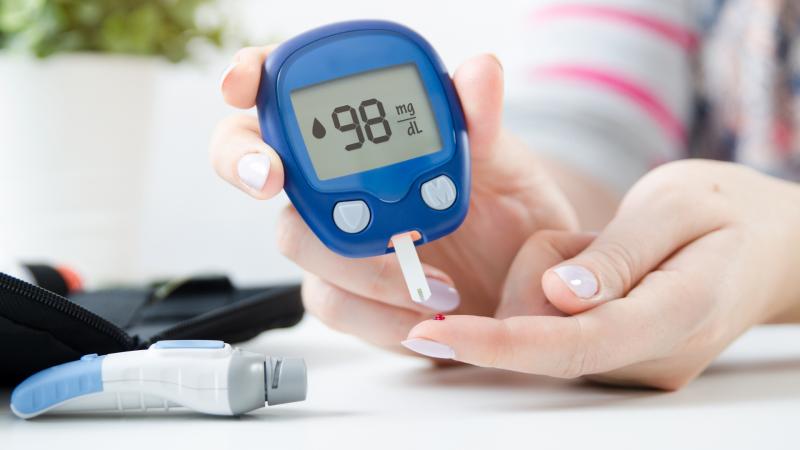
Diabetes is a significant health concern across the world, with about 463 million people over the age of 18 living with the condition. This number is expected to increase to 700 million by 2045. Diabetes is a metabolic disorder where the body does not produce or effectively use the hormone insulin, resulting in elevated levels of glucose in the blood. Monitoring the amount of blood glucose can aid effective diagnosis, treatment and access to quality healthcare management to diabetic patients.
One of the ways to monitor blood glucose is through commercially available biosensors. At intervals recommended by the physician, people with diabetes use a tiny needle to prick their fingertips and place a drop of blood on the sensor to measure the amount of glucose. Although such a test can be done at home at any time, there is a growing need to have pain-free alternatives. Hence, researchers are exploring glucose biosensors that do not need so much blood and are reliable, accurate, biodegradable, biocompatible and user-friendly.
In a recent study, published in the journal Scientific Reports, researchers at the Indian Institutes of Technology Indore and Bombay, have developed one such sensor. It consists of micron-sized spherical particles composed of alginates—a natural biopolymer that can form gels. The alginate spheres contain polymeric nanoparticles loaded with glucose oxidase enzyme and platinum porphyrin. These hybrid particles can detect changes in oxygen and glucose concentration and indicate it through a difference in the intensity of light emitted by the particles.
Customarily, glucose biosensors have an enzyme embedded in it and the interaction of this enzyme with glucose aids in the measurement of glucose concentration. Glucose oxidase enzyme facilitates the reaction between glucose and oxygen. Platinum porphyrin—an inorganic compound that absorbs light radiation in the visible region and re-emits in the near-infrared region—is used as a dye to detect and signal the changes occurring in the reaction. In the presence of oxygen, the intensity of the re-emitted light by platinum porphyrin changes.
The researchers have encapsulated platinum porphyrin in polymer nanoparticles like poly-lactic acid and poly-lactide-co-glycolide, which are biocompatible and are non-toxic to our tissues. Nanoparticles, due to their tiny size, have a higher surface area and hence have better sensitivity to detect glucose levels. The dye-loaded polymer nanoparticles and glucose oxidase enzymes are packed in porous, biodegradable alginate spheres that are as thick as a human hair. As these spheres are micron-sized, they diffuse lesser than nanoparticles and hence, do not spread through the blood vessels.
The researchers envision that the hybrid particles can be used in the making of implantable biosensors, such as a tattoo-like or wristband-like sensors. Such implantable biosensors are placed on the skin, a small probe or needle is inserted into the skin, and the sensor measures the glucose concentration present in the interstitial fluid - fluid that is present around the cells.
“These hybrid particles can form the basis of implantable biosensors based on smart tattoo concept as the matrices can stay in the subcutaneous tissue,” say the researchers.
So, how do the hybrid particles detect glucose concentration? When glucose is added to a suspension containing these hybrid particles, the glucose oxidase enzyme accelerates the reaction between glucose and oxygen. As oxygen gets consumed in the process, its concentration decreases and the intensity of light emitted by platinum-porphyrin increases. If the sample has a higher concentration of glucose, then the amount of oxygen consumed would be more, thereby, increasing the intensity of the emitted light. The study found that poly-lactic acid nanoparticles showed better efficiency and sensitivity to detect glucose.
Further, the researchers analysed the functioning of the encapsulated enzyme and platinum porphyrin. They found that while the enzyme activity decreased over time, the platinum porphyrin dye stayed stable. The study found that the hybrid particles were able to detect glucose and provided accurate response up to 15 days.
The researchers also tested the toxicity of these hybrid particles on proteins of connective tissue of mice. Properties of the cell, like, adhesion, multiplication and viability were seen to be unaffected in the presence of the hybrid particles. The population of healthy cells was found to be reduced in the presence of surfactants or on direct contact with platinum porphyrin. Thus, encapsulation of platinum porphyrin within the polymer matrix makes the sensor more suitable for biomedical applications as it reduces the possibility of the dye having direct interaction with cells.
While the road ahead for such implantable biosensors to become mainstream is long, the researchers are optimistic about the synthesised hybrid particles as it shows promising potential in detecting and indicating glucose concentration.






